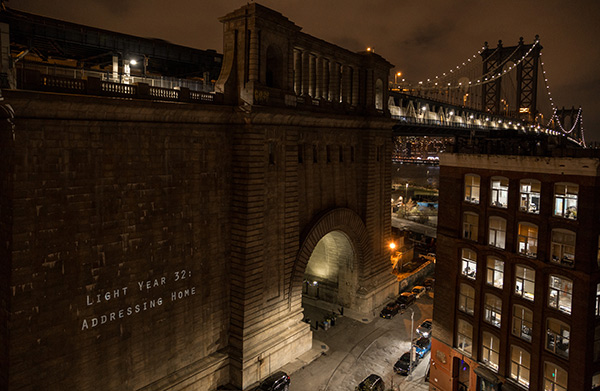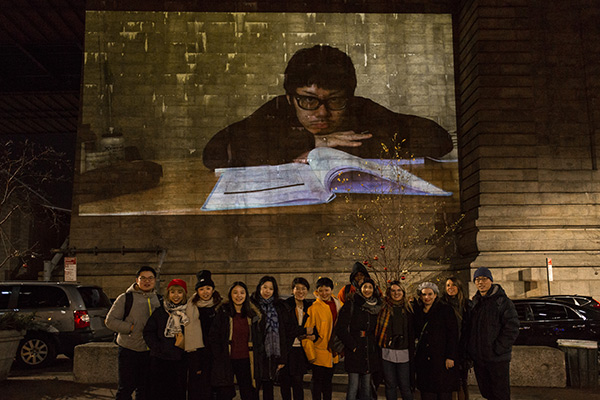“Home” is Where the Art Is
In early December, 11 TC students projected videos about the concept of home onto the side of the Manhattan Bridge

The actual product was “Light Series 32: Addressing Home,” a series of student-created videos projected onto the anchorage of the Manhattan Bridge, the venerable suspension span that crosses the East River in New York City, connecting Lower Manhattan at Canal Street with Downtown Brooklyn at the Flatbush Avenue Extension. The 38-minute show was part of Light Year, a monthly video art and mapping series using the bridge that is curated by Leo Kuelbs, a curator whose projection work has appeared in cities around the world. Kuelbs originated the concept of “Addressing Home” and was overall organizer of the TC student show, while Jesse Jagtiani, an artist, researcher and educator who is pursuing her TC doctorate and who coordinates TC’s Myers Media Studio, was the invited curator.
The TC student exhibition was arranged by Richard Jochum, Associate Professor of Art & Art Education, who in 2011 co-created a “human waterfall” as part of an award-winning 30,000-square-foot projection work that was shown on the bridge, called Immersive Surfaces, with Kuelbs as curator. The work shared honors as the best exhibition at the DUMBO Art Festival, and CNN called it one of the 10 best video mapping projects worldwide.

Creating projections on a scale and surface like the bridge anchorage is a technological feat requiring computers and powerful lighting equipment – but technology was not the main attraction of the “Addressing Home” exhibition.
“You need to tell stories that are meaningful,” says Jochum.
The artists – students in Instructor Jagtiani’s Video Art class – were fulfilling an assignment that asked them to envision places that are or have been called home in different cultures and eras.
“As times change, so does the meaning of ‘home,’” wrote Jagtiani in a brochure for the exhibition. “A cave, a high rise, a tree, a hut – the places shift, but our relationship to family and those close is a constant element. We live in different cities, states, countries and continents, comprising diverse religion, races, cultures and belief systems, but in the end, we are all humans of this one earth that necessitate a home.”
Among the videos were:
“Did I Spark Your Life,” by Evy Yiran, which explores how young couples who come together from different sides of the world share parts of themselves and explore differences through language, food, culture and customs.
“Silk,” by Anamaria Amador, which conveys an “inner sense of home” expressed by the symbol of the butterfly.
“Space Station,” by Yang Yang, in which the striking image of a pot of yellow noodles is framed against a black background, like a full moon. “We are afraid of loneliness, but sometimes we need a space of our own,” writes Yang.
“That Trinket I Treasure,” by Jagtiani herself, which presents “memories of a filed trip taken with friends shortly before the artist was required to leave the country after many years of living in the USA.” The video represents “the search for home, memories of yesterday, and the longing for moments of belonging.”
The other students who exhibited their work were Hiroshi Haga, Wentian Ma, Wang Xi, Junying Lu, Ziyun Tao, Xihun Zhang, Daniel Ahn and Kasey Clark. To see images from all the student videos in the exhibitions, click on the embedded Flickr gallery.
Showing student work outside of TC is very important to Jochum, who has helped to initiate a student exhibition at the Luchsinger Gallery in Greenwich, Connecticut, in late January.
“This helps us bring our program out into the community, enhance visibility for our current students and attract students for the future,” he says. “We also do this to bring what TC is doing out into the world. It’s all about pushing those boundaries.”
Published Friday, Dec 22, 2017
